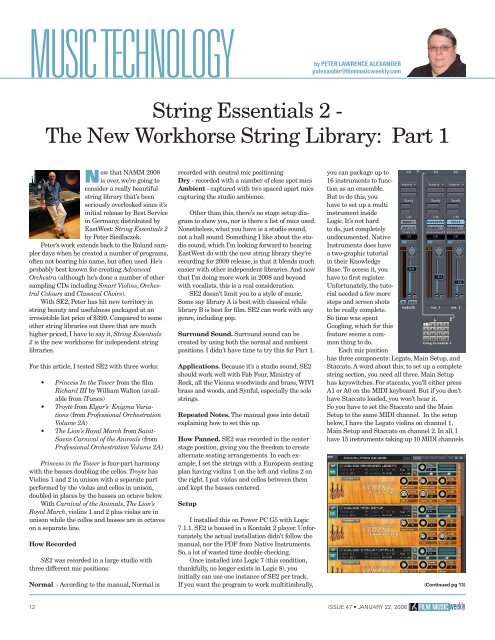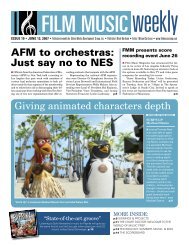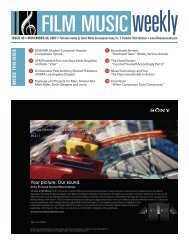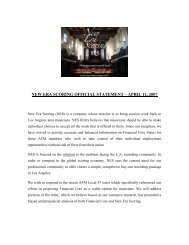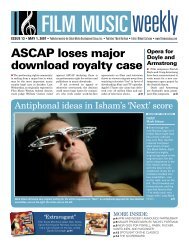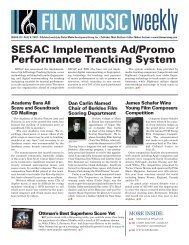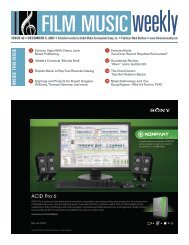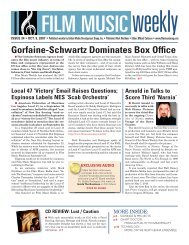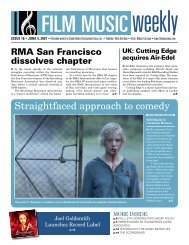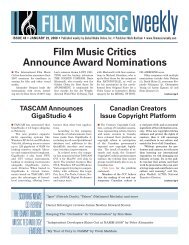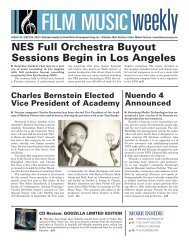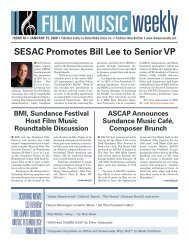ASMAC Announces George S. Clinton Master Class Feb 16, Golden ...
ASMAC Announces George S. Clinton Master Class Feb 16, Golden ...
ASMAC Announces George S. Clinton Master Class Feb 16, Golden ...
You also want an ePaper? Increase the reach of your titles
YUMPU automatically turns print PDFs into web optimized ePapers that Google loves.
MUSIC TECHNOLOGY<br />
by PETER LAWRENCE ALEXANDER<br />
palexander@filmmusicweekly.com<br />
String Essentials 2 -<br />
The New Workhorse String Library: Part 1<br />
Now that NAMM 2008<br />
is over, we’re going to<br />
consider a really beautiful<br />
string library that’s been<br />
seriously overlooked since it’s<br />
initial release by Best Service<br />
in Germany, distributed by<br />
EastWest: String Essentials 2<br />
by Peter Siedlaczek.<br />
Peter’s work extends back to the Roland sampler<br />
days when he created a number of programs,<br />
often not bearing his name, but often used. He’s<br />
probably best known for creating Advanced<br />
Orchestra (although he’s done a number of other<br />
sampling CDs including Smart Violins, Orchestral<br />
Colours and <strong>Class</strong>ical Choirs).<br />
With SE2, Peter has hit new territory in<br />
string beauty and usefulness packaged at an<br />
irresistible list price of $399. Compared to some<br />
other string libraries out there that are much<br />
higher priced, I have to say it, String Essentials<br />
2 is the new workhorse for independent string<br />
libraries.<br />
For this article, I tested SE2 with three works:<br />
• Princess In the Tower from the film<br />
Richard III by William Walton (available<br />
from iTunes)<br />
• Troyte from Elgar’s Enigma Variations<br />
(from Professional Orchestration<br />
Volume 2A)<br />
• The Lion’s Royal March from Saint-<br />
Saens Carnival of the Animals (from<br />
Professional Orchestration Volume 2A)<br />
Princess in the Tower is four-part harmony<br />
with the basses doubling the cellos. Troyte has<br />
Violins 1 and 2 in unison with a separate part<br />
performed by the violas and cellos in unison,<br />
doubled in places by the basses an octave below.<br />
With Carnival of the Animals, The Lion’s<br />
Royal March, violins 1 and 2 plus violas are in<br />
unison while the cellos and basses are in octaves<br />
on a separate line.<br />
How Recorded<br />
SE2 was recorded in a large studio with<br />
three different mic positions:<br />
Normal - According to the manual, Normal is<br />
recorded with neutral mic positioning<br />
Dry - recorded with a number of close spot mics<br />
Ambient - captured with two spaced apart mics<br />
capturing the studio ambience.<br />
Other than this, there’s no stage setup diagram<br />
to show you, nor is there a list of mics used.<br />
Nonetheless, what you have is a studio sound,<br />
not a hall sound. Something I like about the studio<br />
sound, which I’m looking forward to hearing<br />
EastWest do with the new string library they’re<br />
recording for 2009 release, is that it blends much<br />
easier with other independent libraries. And now<br />
that I’m doing more work in 2008 and beyond<br />
with vocalists, this is a real consideration.<br />
SE2 doesn’t limit you to a style of music.<br />
Some say library A is best with classical while<br />
library B is best for film. SE2 can work with any<br />
genre, including pop.<br />
Surround Sound. Surround sound can be<br />
created by using both the normal and ambient<br />
positions. I didn’t have time to try this for Part 1.<br />
Applications. Because it’s a studio sound, SE2<br />
should work well with Fab Four, Ministry of<br />
Rock, all the Vienna woodwinds and brass, WIVI<br />
brass and woods, and Synful, especially the solo<br />
strings.<br />
Repeated Notes. The manual goes into detail<br />
explaining how to set this up.<br />
How Panned. SE2 was recorded in the center<br />
stage position, giving you the freedom to create<br />
alternate seating arrangements. In each example,<br />
I set the strings with a European seating<br />
plan having violins 1 on the left and violins 2 on<br />
the right. I put violas and cellos between them<br />
and kept the basses centered.<br />
Setup<br />
I installed this on Power PC G5 with Logic<br />
7.1.1. SE2 is housed in a Kontakt 2 player. Unfortunately,<br />
the actual installation didn’t follow the<br />
manual, nor the PDF from Native Instruments.<br />
So, a lot of wasted time double checking.<br />
Once installed into Logic 7 (this condition,<br />
thankfully, no longer exists in Logic 8), you<br />
initially can use one instance of SE2 per track.<br />
If you want the program to work multitimbrally,<br />
you can package up to<br />
<strong>16</strong> instruments to function<br />
as an ensemble.<br />
But to do this, you<br />
have to set up a multi<br />
instrument inside<br />
Logic. It’s not hard<br />
to do, just completely<br />
undocumented. Native<br />
Instruments does have<br />
a two-graphic tutorial<br />
in their Knowledge<br />
Base. To access it, you<br />
have to first register.<br />
Unfortunately, the tutorial<br />
needed a few more<br />
steps and screen shots<br />
to be really complete.<br />
So time was spent<br />
Googling, which for this<br />
feature seems a common<br />
thing to do.<br />
Each mic position<br />
has three components: Legato, Main Setup, and<br />
Staccato. A word about this; to set up a complete<br />
string section, you need all three. Main Setup<br />
has keyswitches. For staccato, you’ll either press<br />
A1 or A0 on the MIDI keyboard. But if you don’t<br />
have Staccato loaded, you won’t hear it.<br />
So you have to set the Staccato and the Main<br />
Setup to the same MIDI channel. In the setup<br />
below, I have the Legato violins on channel 1,<br />
Main Setup and Staccato on channel 2. In all, I<br />
have 15 instruments taking up 10 MIDI channels.<br />
(Continued pg 13)<br />
12 ISSUE 47 • JANUARY 22, 2008 FILM MUSICweekly


